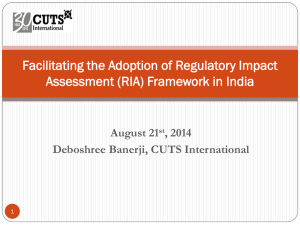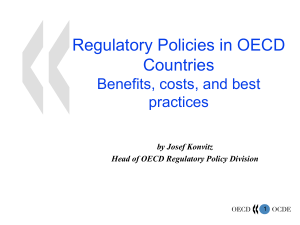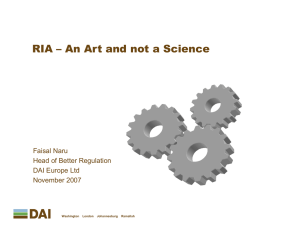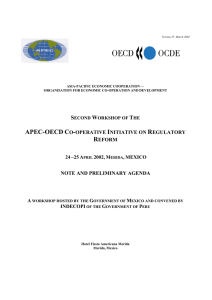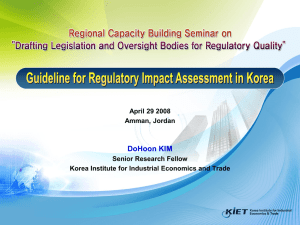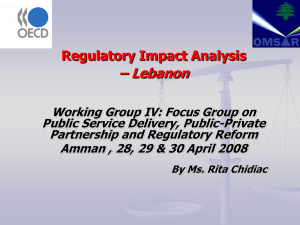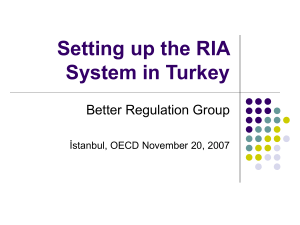An overview of OECD Strategies for Improving Regulatory Performance Mr Gregory Bounds
advertisement
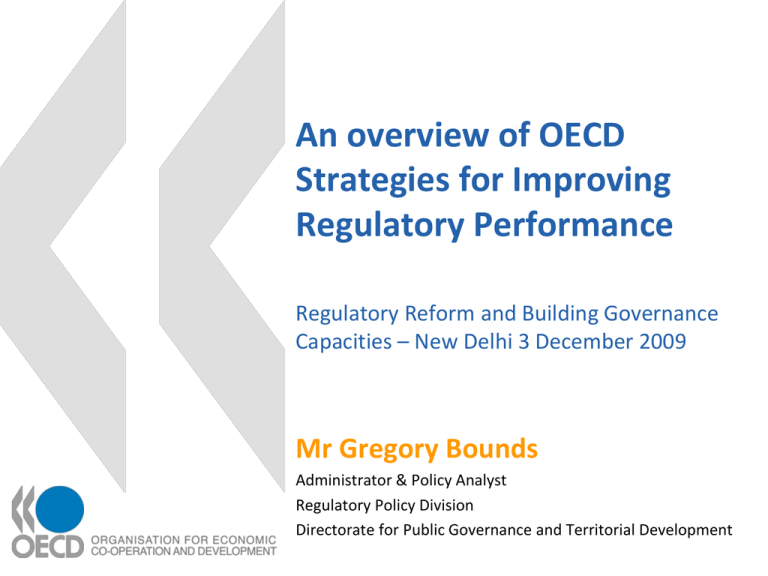
An overview of OECD Strategies for Improving Regulatory Performance Regulatory Reform and Building Governance Capacities – New Delhi 3 December 2009 Mr Gregory Bounds Administrator & Policy Analyst Regulatory Policy Division Directorate for Public Governance and Territorial Development What is the OECD experience of Improvements to Regulatory Quality? For all Governments, improvements to the efficiency and effectiveness of regulation can deliver significant benefits: • Increase social welfare through more effective social and economic policies • Boost economic development by encouraging market entry and competitiveness • Control regulatory costs and improve productive efficiency, particularly for small to medium sized enterprises • Improve the rule of law , transparency and participative democracy Challenges to Delivering High Quality Regulation All Governments find it difficult to control the quality and quantity of regulation, this can be due to: • • • • • • Lack of coordination and planning capacities to promote coherent reform across government Vested interests may block reform, particularly where decision processes are not transparent and accountable Political incentives favour short term interests over long term social policy goals Regulation becomes outdated in changing environments Regulation is exercised by many levels of government and may be duplicative or excessive Regulators may not be equipped, or have incentives, to assess the cost of regulation and whether regulation is a practical solution OECD Guiding Principles for Regulatory Quality and Performance (2005) The OECD promotes Regulatory Reform as a dynamic long term process applying across government. • OECD considers that a successful approach to regulatory governance focuses on: • regulatory policies • regulatory tools • regulatory institutions Regulatory Policies are Necessary for Progress • • Effective reform requires organised procedures with sustained political backing and adequate resources Policies have two main elements: improving rule making and keeping regulations up to date The emphasis varies but the main objectives of regulatory policies tend to be: • Increasing social welfare through more effective social and economic policy • Controlling regulatory costs for business development • Improving public sector efficiency and performance • Reducing regulatory discretion and opportunities for corruption, and improving access to regulation Tools to Improve Regulatory Design • • • • The systematic use of tools is needed to promote regulatory quality, efficiency and effectiveness. These include: Regulatory Impact Analysis (RIA) to improve the evidence basis for regulatory decisions Public consultation strategies to promote transparency, accountability and improve regulatory design The evaluation of alternatives to regulation to best address the policy problem Red tape reduction programs to reduce administrative and compliance costs RIA uses evidence based decision making to improve the efficiency of regulation, and avoid regulatory failure For each regulatory proposal RIA requires the analyst to: Identify and define the problem to be addressed • Spell out the desired objective(s) • Elaborate the different options, considering alternatives • Consult with affected groups • Analysing the options, considering the costs and benefits • Recommend the policy option with the greatest net benefit • Communicate with the public • Monitor and report on the performance of regulation • 2008 2007 2006 2005 2004 2003 2002 2001 2000 1999 1998 1997 1996 1995 1994 1993 1992 1991 1990 1989 1988 1987 1986 1985 1984 1983 1982 1981 1980 1979 1978 1977 1976 1975 1974 Adoption of RIA in OECD countries 30 25 20 15 10 5 0 RIA Requirements in OECD Countries Formal requirement by law Requirement for draft primary laws Requirement for draft subordinate regulations Requirement to identify the costs of new regulation Requirement to identify the benefits of new regulation 1998 2005 2008 Requirement to demonstrate that benefits of regulation justify the costs 0 5 10 15 Number of jurisdictions 20 25 30 31 Common challenges in implementing RIA Related to the tool: • Problem identification • Consultation and data • Considering alternatives • • • “Proportionate analysis” Quantification Risk assessment Related to the structure/process • Scope of application / selection of proposals • Quality control (oversight) • Presentation / Communication • Integrate RIA up-stream (early in decision-making) • Integrate RIA down-stream (“closing the loop”) • Training • Multi-level context Programs to Reduce Administrative Costs of existing regulation are frequently used across OECD Measurement of Administrative Burdens (Administrative compliance costs imposed by regulation) Public Sector (Regulation Inside Government) Private Sector Businesses • Inspections • Reporting • Permits Citizens • Inspections • Reporting • Permits = time is money Red Tape Reduction Tools include: setting paperwork reduction targets, one-stop shops, reduced reporting requirements, regulatory exemptions for small business, better use of ICT… Institutions to drive Regulatory Policies • The right set of institutions are required to ensure regulatory implementation: Regulatory oversight bodies with whole of government responsibility • • • • • • Advocate benefits of reform Perform a gatekeeper role on quality of RIA Provide training and clear guidance to regulators Ministerial accountability for regulatory policy Measureable programs to reduce administrative burdens Careful design of independent regulators What are the challenges to improving regulatory quality in India? Some thoughtful questions: • • • • • What are the main issues affecting regulatory quality in India? Is there political support for regulatory reform? Is there an evidence based approach to policy making? How much of a problem are administrative burdens, and is it being tackled? Do independent regulators have clearly defined roles?

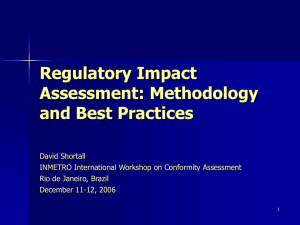
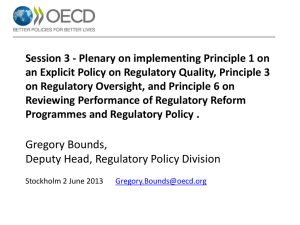
![----Original Message----- From: Doug Lippoldt [ ]](http://s2.studylib.net/store/data/015588501_1-6722fcef821424ff69e70c18123d54fe-300x300.png)
